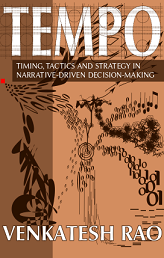I’ve been obsessed with the concept of an aesthetic recently. In particular, aesthetics applied to things other than art and design. I’ve come to believe that your aesthetic posture is one of the most important determinants of how you think.
This post was threatening to snowball into a 10,000 essay (here’s why) so I decided to spare you the pain and provide three sampler pieces of the dozen or so I am trying to assemble into…something. Instead I’ll leave you to try and assemble something out of these pieces yourself.
Hint: you may want to try viewing a variety of distinct examples that are not formally pieces of art using these three constructs. Like say, coffee, the Republican/Democrat parties (in America), popcorn, a slum, a forest, a language, a mathematical result, a piece of code, an approach to planning a vacation, a way of organizing a desk…. So here you go, your first DIY ribbonfarm post.
First, always a good idea to start with a 2×2. Here, the challenge was to come up with a useful y-axis.

Next, an attempt to link aesthetics with attitudes about time. Paired-term lists are always good for exploring a dichotomy, and time is a reliably fertile variable to attempt to link to just about anything else.







